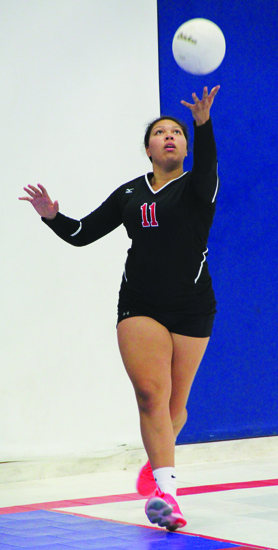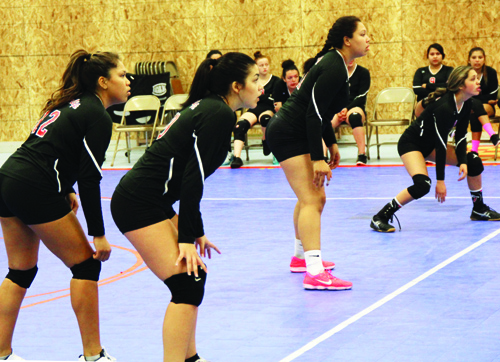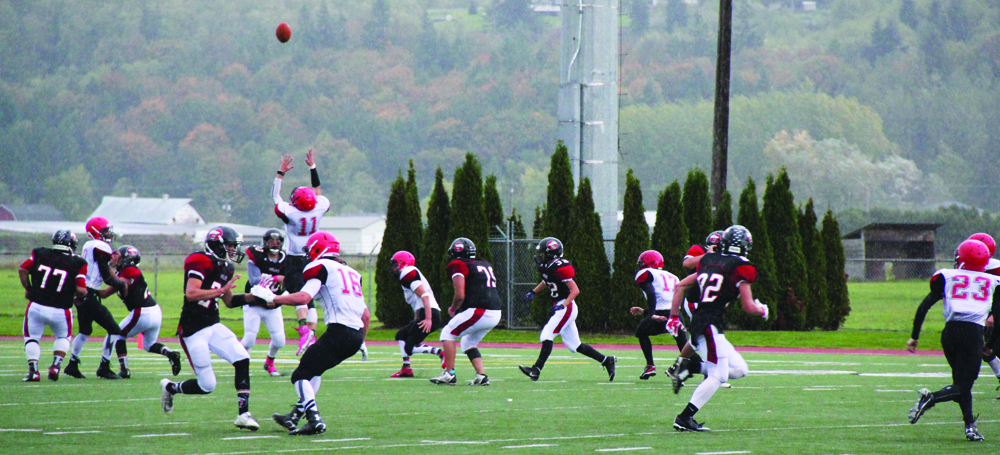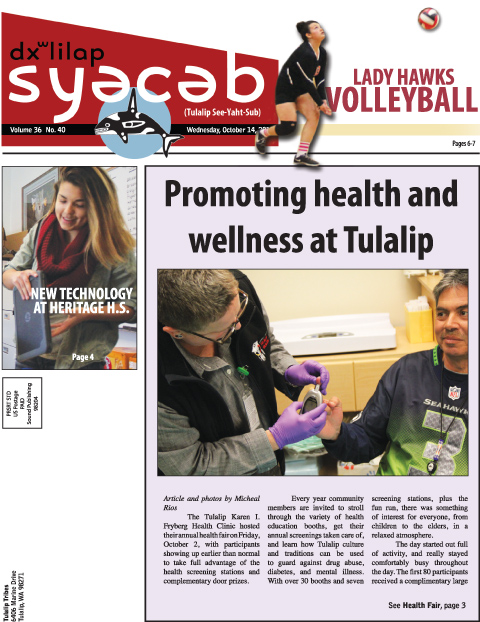Month: October 2015
Lady Hawks keep games competitive, but unable to close against Lobos and Knights
by Micheal Rios, Tulalip News
On Friday, October 9, the Tulalip Heritage Lady Hawks (3-4) volleyball team traveled to Lopez Island to take on the (5-1) Lobos. It was the second time these two teams have faced each other, with the previous being a 0-3 loss at home for Tulalip.
This time around the Lady Hawks had their full squad of players and have been playing very good team volleyball. The Lady Hawks were able to keep the score close in each game, countering each Lobos point with a point of their own. Surprisingly, two of the three games were played beyond the 25 point mark because neither team was able to take a two-point advantage. Unfortunately, even with the great effort being displayed by the Lady Hawks they would fall just short in both of those games.
The Lobos won the match 3-0 over the visiting team, but Tulalip gave them all they could handle and if only a couple points had gone differently they could have won the match.
On Tuesday, October 13, the Lady Hawks (3-5) again hit the road and traveled the short distance to Cascade Christian Reformed Church in Marysville to play the Arlington Highland Knights (4-4). It was also the second time these two teams had faced each other, with the previous being a very competitive 0-3 defeat at home for Tulalip.
This match would have substantial repercussions on the Northwest 1B volleyball standings. Currently sitting in the #4 spot are the Knights and only one game behind them are the Lady Hawks at #5. With a win the Lady Hawks could have the inside track to being the #4 seed come playoff time, meaning they would host a home playoff game.
Prior to the game, coach Tina Brown spoke about the team’s mindset heading into this big matchup. “We’ve been working hard in practice and going over game film to have the girls see what areas of their game needs improvement. They agree communication is our number one area to focus on. Our communication has been the biggest factor in our wins and in our losses. If we focus on communicating and helping each other out, then this will be a great game. We have to communicate and trust each other.”
In the 1st game, everything that could go wrong for the Lady Hawks did go wrong. Early season struggles of hitting their serves in play was once again an issue. The Lady Hawks were giving away easy points to their opponent simply because they weren’t getting the ball over the net on their serves. As this continued to happen in the first game, the team really struggled to play together and they stopped communicating. The Knights went on to win the 1st game 25-13, in large part to the 7 unforced errors the Lady Hawks committed in their serving game.
In the 2nd game, the Lady Hawks cleaned up their service game and only committed 3 unforced errors. Getting the ball over the net got the girls engaged into the game and they communicated like they know how. Tying the game at 10-10 and then again at 20-20, the Lady Hawks were in good position to win the game. However, the Knights called timeout after the game was tied at 20-20 to talk things over. Their coach noticed the Tulalip front line players were moving way too close to the net, resulting in holes in the back line of the Tulalip defense. Out of their timeout, the Knights were able to capitalize on their coach’s advice and went on a 5-2 run to seal the game 25-22 by aiming for those holes in Tulalip’s back line.
In the 3rd game, the Lady Hawks started out hot and led by Adiya Jones serving four straight aces, took a 8-4 lead. The game was highly competitive and the Lady Hawks were playing their best ball of the match. After only giving up two points on bad serves, they were able to take a 23-18 lead. For whatever reason though, the Lady Hawks tightened up only needing a couple points to win the game and they stopped communicating with each other. Going back to what their coach said prior to the game, if they don’t communicate and trust each then they won’t be able to pull out a victory. And that’s exactly what happened. The Lady Hawks blew their 23-18 lead and lost the game 25-27, resulting in a 0-3 match defeat.
Both matches of this road trip were winnable by the Lady Hawks if they could just learn to communicate effectively for an entire match, not just for minutes at a time, and close out the games they are leading. Now sitting at 3-6 on the season, the playoffs are still a realistic goal, but only if the Lady Hawks clean up their game.
Indigenous women take climate matters into their own hands

David McNewGetty Images
By Justine Calma, Global Post
NEW YORK — Not far from the negotiations for a new global development agenda that took place between heads of state at the United Nations General Assembly last month, a small group of female leaders gathered out of the limelight to sign another historic agreement.
The delegation chose not to meet at UN headquarters in east Midtown but on a traditional Native American tribal territory in Central Park’s East Meadow.
Seven women representing eight different tribes signed a treaty to unite the indigenous women of the Americas in friendship to protect the land and people from the harms of climate change and environmental degradation.
In what organizers said was the first-ever indigenous women’s treaty, the women pledged to support the rights of indigenous peoples, commit nonviolent acts of civil disobedience to protect the planet, and demand immediate changes to laws that have led to environmental destruction.
“We’re saying this is the line. We’re done. The destruction stops now,” said Pennie Opal Plant, one of the treaty’s lead signers.
The United Nations recognizes that women are more vulnerable to the effects of climate change because they constitute a majority of the world’s poor and are more dependent on natural resources for their livelihood.
“Women’s role as central stakeholders is one of the most important, yet untold stories of climate change. If we are to have a fighting chance at restoring the health of the Earth and our communities, women’s experiences and knowledge must be brought to the forefront,” said Osprey Orielle Lake, the executive director of Women’s Earth and Climate Action Network (WECAN), at an event where the treaty was later presented.
The signed treaty contends that the laws of Mother Earth “have been violated to such an extreme degree that the sacred system of life is now threatened and does not have the capacity for life to continue safely in the way in which it has existed.”
Opal Plant, who is of the Yaqui, Choctaw and Cherokee tribes, was instrumental in shaping the treaty. She grew up in the shadow of Chevron and Shell refineries in the eastern part of the San Francisco Bay Area, where she saw environmental degradation first-hand. She has organized nonviolent prayer walks in her home city led by Native American elders, but after connecting with other women during a gathering of nature rights advocates in Ecuador 2014, Opal Plant saw opportunity to launch a worldwide movement. She joined several other indigenous leaders from the US and Ecuador — Casey Camp-Horinek of the Ponca tribe, Patricia Gualinga Montalvo and Blanca Chancoso of the Kichwa, and Gloria Hilda Ushigua Santi of the Sápara.
“When women unite and commit to something, shifts happen,” said Montalvo, speaking through an interpreter. “I feel strongly that it’s a time to be heard and for actions to take place.”
Montalvo played a large role in successfully fighting the Ecuadorian government in 2012 in a landmark Inter-American Court of Human Rights case, Sarayaku v. Ecuador, in which the Ecuadorian government was found guilty of rights violations after authorizing oil exploration on Sarayaku lands without prior consultation with the indigenous community.
Opal Plant and her treaty co-signers presented their document at an event hosted by WECAN on Sept. 29, a Global Women’s Climate Justice Day of Action.
Women are disproportionately impacted by climate change, and they are central to solutions, said Orielle Lake at the event.
In the coming months, Opal Plant and her co-signers will create a website to expand the treaty beyond the Americas and allow other groups to sign online. In December, they plan to bring the treaty to COP21, the Paris Climate Conference, and hold another ceremony where more indigenous women leaders will join.
Montalvo’s indigenous community in Sarayaku is constructing a canoe that will travel from Ecuador to France. “The canoe is a symbol of Sarayaku, a symbol of our living forest,” said Montalvo. “We will bring it all the way to Paris so it can navigate the River Seine and so we will be heard.”
In New York, WECAN also presented a Women’s Climate Declaration, which includes a demand to bring back atmospheric carbon dioxide concentrations to below 350 parts per million — which many scientists agree is a level that avoids catastrophic global warming — and an aim to ensure that women’s groups have access to funding to adapt to climate change that is already happening. The declaration already has garnered over 2 million signatures and will be delivered at COP21 later this year.
Women comprise 20 million of the 26 million people estimated to have been displaced by climate change, according to a 2010 report by the Women’s Environmental Network.
“I ask that as temperature rises, that we rise,” said Orielle Lake.
Tulalip Hawks lit up by the Neah Bay Red Devils, 12-72
by Micheal Rios, Tulalip News
Coming off their first win of the season, a 78-48 victory over Crescent High School, the Tulalip Heritage Hawks (1-3) were looking forward to a competitive game against one of their rivals, the Neah Bay Red Devils (3-0). The Red Devils are the back-to-back WA State 1B champions, currently ranked #32 in the nation, and ranked #1 in the state. The Red Devils have been destroying teams by an average margin of 37 points per game and appear prime to repeat again as 1B champions.
The game was played at Quil Ceda stadium on Saturday, October 10, where clouds opened up to rain showers just before kick-off.
On the opening kick-off the Red Devils scored on an 87-yard kick return, completed the 2-point conversions, and took an 8-0 lead over Tulalip Heritage less than 15 seconds into the game. On the Hawks ensuing possession they went 3 and out, but their 4th down punt attempt went awry as the snap was low and the ball was fumbled. The Red Devils took over on downs at the Hawks 22-yard line and on 1st down scored an easy touchdown to take a 14-0 lead.
It would be that kind of day for the Hawks, as the Red Devils were just too good, took advantage of every Hawks miscue, and continued to pile on the points.
Down 0-44 with 90 seconds left in the 1st quarter the Hawks got on the board. From their own 45-yard line, quarterback Willy Enick dropped back and connected to Robert Miles on a 15-yard throw. Miles shed a would-be tackler and was off to the races for a 55-yard touchdown.
The Red Devils would add another touchdown right before the end of the 1st quarter, giving them a 50-6 lead over the home team after the opening quarter.
Early in the 2nd quarter Willy Enick again connected with wide receiver Robert Miles for a 74-yard catch and run touchdown for the Hawks. This time it was a well-timed throw by Enick that caught Miles in stride and led him past the Red Devils secondary for the score. The 12-50 score was the closest the Hawks would get unfortunately.
The Hawks would be held scoreless for the remainder of the game and would go on to lose 12-72. It was definitely a humbling experience for the home team who with the loss now sit at 1-4 on the season. Next up is an away game at Clallam Bay on Friday, October 23.
Toxic road runoff kills adult coho salmon in hours, study finds
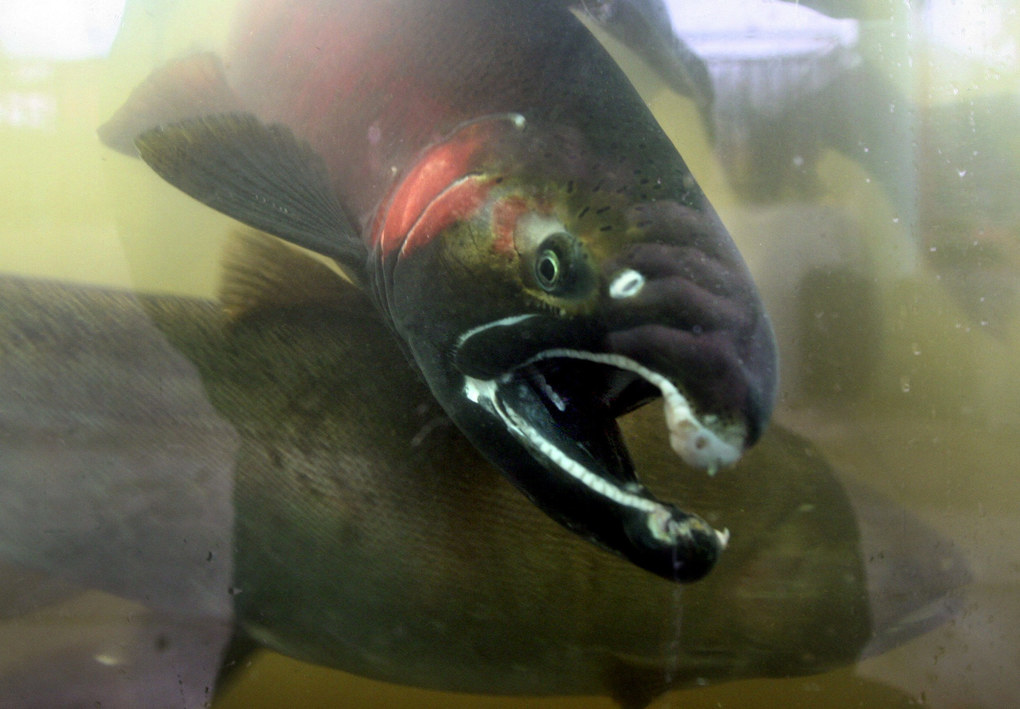
A new study shows that stormwater runoff from urban roadways is so toxic to coho salmon that it can kill adult fish in as little as 2½ hours.
But the research by Seattle scientists also points to a relatively easy fix: Filtration through a simple, soil-based system.
“It’s basically … letting the Earth do what it does so well, what it has done for eons: cleaning things up,” said Julann Spromberg, a toxicologist for the National Oceanic and Atmospheric Administration and co-author of the report published Thursday in the Journal of Applied Ecology.
Scientists have long suspected that the mixture of oil, heavy metals and grime that washes off highways and roads can be poisonous to coho, but the study is the first to prove it.
The research got its start more than a decade ago, when habitat-restoration projects began coaxing a trickle of coho back to several urban streams in the Puget Sound area. But many of those fish died before they could spawn. And the deaths seemed to coincide with rainstorms that sent runoff surging through drainage pipes and into the waterways.
In some place, like Longfellow Creek in West Seattle’s Delridge area, up to 90 percent of females were killed.
“It was apparent that something coming out of those pipes was causing it,” Spromberg said.
She and her colleagues tried to reproduce the effect in the lab. But the artificial mixture of oil and other chemicals they concocted had no effect on the fish.
So their next step was to try the real thing: Actual runoff, collected at NOAA’s Northwest Fisheries Science Centerfrom a downspout that drains a Highway 520 onramp near Montlake.
“When we brought out the real urban runoff: Bang! They were down, they were sick, they were dead,” said co-author Jenifer McIntyre, a researcher at Washington State University’s Puyallup Research and Extension Center.
In experiments at the Suquamish tribal hatchery near Poulsbo, every coho exposed to the runoff died — some within a few hours, all within a day. Before death, the fish became lethargic, rolled around and swam to the surface as if gulping for air, McIntrye said.
The fact that actual runoff proved fatal while the scientists’ concoction did not underscores an unsolved mystery about which chemical or combination of chemicals are so toxic to the fish. It could be any number of compounds that weren’t part of the artificial brew, including byproducts of oil and gasoline combustion, chemicals released by tires or tiny particles from brake linings, Spromberg said.
But whatever the chemical culprit, the scientists found it could be removed by passing the runoff through 55-gallon drums packed with layers of gravel, soil and compost. None of the fish exposed to the filtered stormwater died or fell ill.
“It was remarkable,” McIntyre said.
State regulations strongly encourage developments to use such approaches, according to the Washington Department of Ecology. A project called 12,000 Rain Gardens in Puget Sound is also promoting their use.
“We should be seeing more and more of these systems in the future,” McIntyre said.
Coho, which were once abundant throughout the Northwest, may be particularly vulnerable to toxic runoff because they spawn in the fall, prompted by seasonal rains. Habitat destruction, fishing and other factors almost certainly contributed to the species’ precipitous decline, Spromberg said.
Chum salmon, whose habitat and spawning seasons overlap those of coho in many places, don’t appear to be as affected by runoff — something the scientists plan to investigate this fall.
Perhaps the major limitation of the study is the small sample size. Only 60 coho were used in the experiments, 20 in each of two experimental and one control groups. The scientists were lucky to get that many, thanks to the cooperation of the Suquamish Tribe, McIntryre said.
Also, the urban runoff collected near Montlake was undiluted in the experiments and represents about the worst possible case: runoff from a busy highway in a big city, a DOE official who was not involved in the study pointed out.
“It’s great that the treatment gets rid of toxicity from this nasty stuff,” Karen Dinicola of DOE’s stormwater program wrote in an email. But it’s particularly challenging to retrofit urban-collection systems with greener alternatives, she said.
But the results of the research could help guide future development in rural watersheds where coho runs remain, the researchers said. And it can also be used to help inform urban-restoration projects as well, so fish aren’t lured back to appealing habitats, only to be clobbered by toxic runoff.
The researchers are preparing for their next round of studies, which will include tests to zero in on what is actually killing the coho.
The rain that soaked the region Wednesday also filled their runoff-collection barrels, Spromberg said.
“We only have one shot a year, when the fish come back and we can do the experiments and take the samples,” she said. “Hopefully, with this rain we’ll have more fish coming in soon.”
October 14, 2015 syəcəb
Tribal Youth Football with Archbishop Murphy Wildcats
By: Kayla Joseph
After four seasons of losing to Lakewood Archbishop, the Archbishop Murphy Wildcats ended the Friday, September 18 game with a 45-13 victory over the Cougars. Pictured above #58 #78 #59 holding the line
2nd team O-line: Senior Darion Joseph # 58
Martin Napeahi Jr #59 sophomore
Jesus Echavarria Jr #78 junior
The Archbishop Murphy Wildcats football team also won their home conference game against Sultan, on Friday, September 25, by a score of 48-0.
You can find the Murphy Wildcats, and other high shool sports teams, game schedules and scores at www.maxpreps.com
Matika Wilbur’s Project 562: Natural Wanderment: Stewardship. Sovereignty. Sacredness at the Hibulb Cultural Center
New Exhibition- Matika Wilbur’s Project 562: Natural Wanderment: Stewardship. Sovereignty. Sacredness
October 23, 2015 at the Hibulb Cultural Center and Natural History Preserve
Tulalip, Washington – The Hibulb Cultural Center and Natural History Preserve is proud to present Matika Wilbur’s newest Project 562 collection: “Natural Wanderment: Stewardship – Sovereignty – Sacredness”, an exhibition of Native American portraits and stories that honors and seeks to protect ancestral ways of life and lands in North America. Project 562 offers a creative relationship with people from 562+ Tribal Nations in the United States that builds cultural bridges, abandons stereotypes, and renews and inspires our national legacy.
Matika Wilbur’s Project 562 is an inspiring artistic adventure unfolding the living history of North America’s ancient peoples. Over the last three years and 250,000 miles, Wilbur, one of the nation’s leading photographers, has journeyed tirelessly to hear the stories and imbibe the culture and wisdom of the original peoples of the land. From Alaska to the Southwest, Louisiana to upper Maine, to date she has acquired exquisite portraits and compelling narratives from over 300 tribes. The stunning and unprecedented work of Project 562 has been featured in national and international media, attracted scores of thousands of visitors to galleries and museums in the U.S. and around the world, been awarded leading creativity grants, and drawn invitations from leading universities and institutions. Wilbur’s artistic mission has caused such intense conversation and transformative awareness about the vibrant, multifaceted identity of Native Americans she is brilliantly exploring.
This human-focused artistic undertaking has revealed that at the core of many Native American’s identities and lives in the United States is their indispensable connection to their ancestral lands. Wilbur recently posted in her blog: “Repeatedly in our journey, we have seen that land and associated rights are essential to the exercise of tribal sovereignty and the ability to preserve and promote culture . . . Where there is displacement from a homeland, there has come to be irrepressible yearning and struggle on all fronts for cultural wholeness and identity, as well as for communication and action about such crises.” This has become the rule, not the exception, as Wilbur has encountered in every visit to tribal nations long-standing struggles by activists, seed-keepers, wild rice harvesters, elders, and other culture bearers to maintain and re-establish indigenous rights to natural places and resources. From the Oak Flat’s struggle to maintain access to their sacred prayer place, Miccusookee’s fight for the Everglades, Lummi’s opposition to the coal train, Paiutes in dire battles for water preservation and rights in California, Southwest tribes’ organized protests against fracking and sacred despoliation . . . the list goes on.
Opening on October 23, 2015 at the Hibulb Cultural Center of the Tulalip Tribes, Wilbur is presenting an extraordinary exhibition of Native Americans devoted to honoring and protecting the sacred and natural world, which is one in the same in their world view. Despite western ideologies and systems that undermine this living truth, there remain the “people of the blue green water”, the “people of the tall pine trees”, the “people of the tide.” Wilbur uses portrait art to express the “ecological being” of sitters, imbuing these images and narratives with the aspiration and force of the original stewards of the land, which is vital to not only the sovereignty and dignity of Native Americans, but also the preservation and majesty of the natural world. As she explains: “With Hibulb’ s generous support, I’m able to share these remarkable portraits and narratives before the end of this total project, as it is crucial that these diverse Native Americans’ values and purposes be known right now. And I’ve featured the land itself, places of breathtaking beauty and wonder that inspire me to keep going in this long and demanding journey I’m on. The show is inspired by the peoples I’ve encountered and how I felt (and wrote in my journal) watching a sunrise above the Bonneville Flats in Utah – ‘Never had the earth been so lovely, nor the sun so bright, as just now.’”
To learn more about Project 562 please visit www.project562.com , follow Matika on Instagram @matikawilbur, or email info@project562.com.
Free workshop for marine shoreline landowners
Press Release: Snohomish County
STANWOOD — Snohomish County and Camano Island residents who want to learn how they can protect and maintain and their shoreline property in Port Susan are invited to attend a free workshop at the Lake Goodwin Community Club in Stanwood on Saturday, Oct. 17.
The event, hosted by the Northwest Straits Foundation and the Snohomish County Marine Resources Committee, will feature a presentation by Jim Johannessen, a coastal processes expert.
Workshop topics include how to manage beach and bluff erosion, enhancing beach access, and using native vegetation for slope stability and habitat. Participants will also receive information on free site visits by a private, shoreline management professional to learn how to protect their property.
The workshop is scheduled for 10 a.m. to 12:30 p.m., Saturday, Oct. 17 at the Lake Goodwin Community Club at 17323 42nd Ave NW, Stanwood 98292. Please reserve your spot today. Register online at http://svy.mk/1OW6YjI, by phone with Heidi Lehman, 360-733-1725, or via email at lehman@nwstraitsfoundation.org.
About Snohomish County Marine Resources Committee
The Snohomish County Marine Resources Advisory Committee (MRC) is a citizen-based volunteer committee appointed by the Snohomish County Council. It is one of seven county-based MRC’s, which conduct restoration, conservation, and education projects with diverse partners and community members to meet performance benchmarks. For more information, visit www.snocomrc.org.
About the Northwest Straits Foundation
The Northwest Straits Foundation is a non-profit organization established to support the scientific, restoration, and education projects and programs of the Northwest Straits Marine Conservation Initiative. The Foundation’s mission is to protect and restore the marine resources of the Northwest Straits by supporting research, monitoring, restoration, stewardship, conservation and education programs and projects both at the local and regional level.
For more information contact Lisa Kaufman of Northwest Straits Foundation at 360-733-1725 or Kathleen Herrmann of the Snohomish Marine Resources Committee at 425-388-6414.
Michael Dean Proo
Michael Dean Proo passed away October 5th, 2015 at the age of 42. Michael was born in the bay area, San Leandro California on August 10th 1973. His parents were Max Proo and Carolyn Oliver. Grandparents were Margaret and Dale Holmes.
Michael Moved to Reno Nevada where he lived for the past 18 years with the love of his life Keena Jackson; where they raised their daughter Keisha they enjoyed family time. Michael was all about family and friends his love and passion was cooking and football. His teams were the Raiders and the Oakland A’s and he was proud to represent the bay. He always enjoyed cooking for family and friends he loved to welcome people with his food and laughter and his great sense of humor. He was always making people laugh!
He enjoyed shooting guns, music, sporting events, and concerts, Michael had a love for life. His brother Dennis and him had a unique brotherly love which involved teasing, joking and always getting one up on the other. Their games would always leave you laughing along with them. Michael will be greatly missed by all who loved him!
Michael is survived by Keena Jackson; and their daughter Keisha; his mother Carolyn Oliver and Dennis P. Two brothers Dennis Sarina and Steven Proo. Grandmother Susanna; Aunties Cecile Hansen and Charlene Loback; Uncles Ernie, Phillip, Mario, Michael, Gabriel, and Angel Proo; Mother In-law Jan Gardipe; Father In-law Ted Jackson; Sister in-law Lisa and Kelly Townsend; Sister In-law Kelly and Dave Turner; Niece Deidra Proo and great Niece Dakota Proo; Special Cousins; Devin, Jay, Marc, Martin Napeahi; Marvin, Jeff, Melissa Velazquez, Katrina Lane. He was preceded in death by his Father Max Proo



